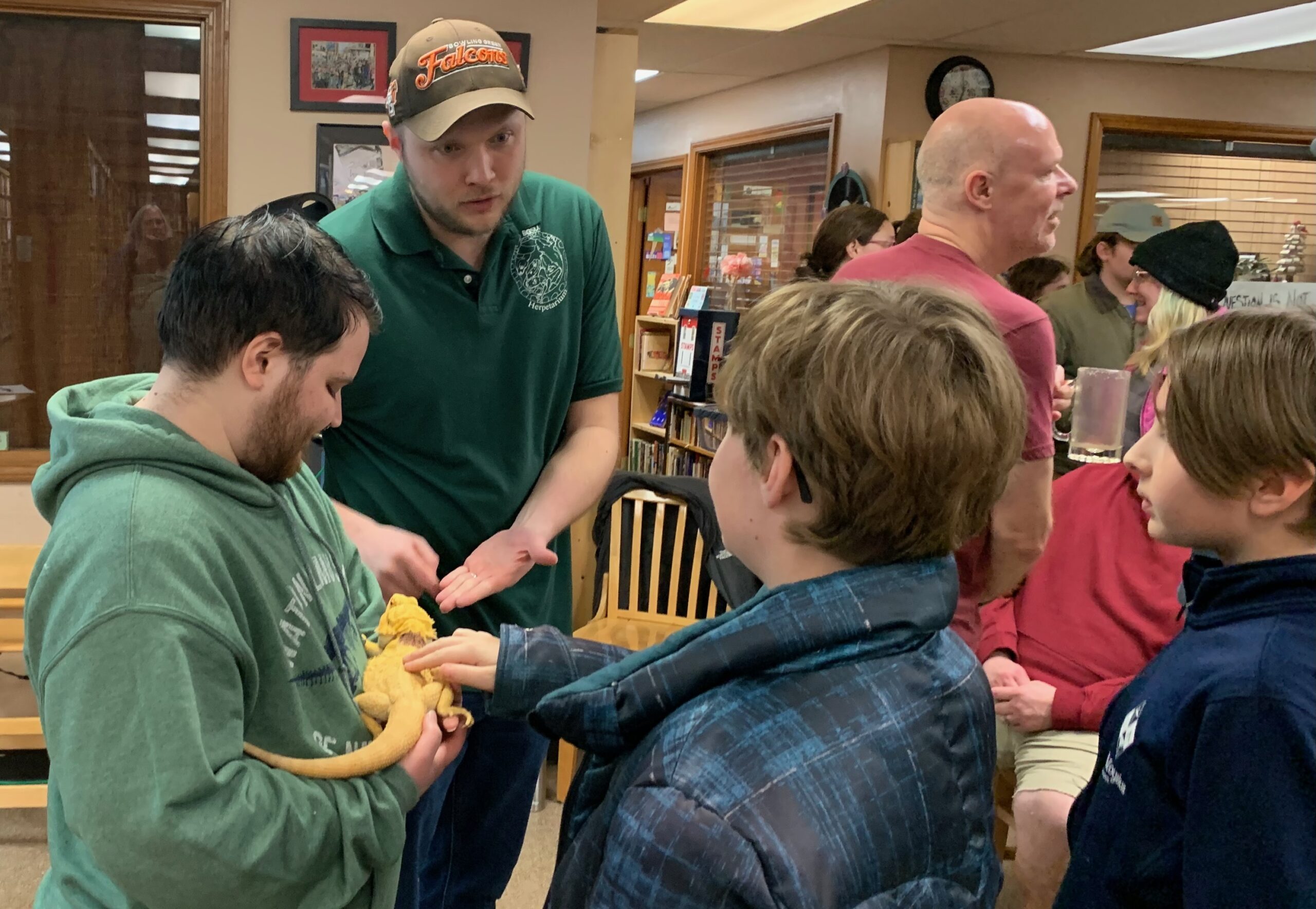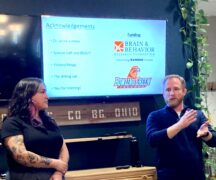By JULIE CARLE
BG Independent News
A Bowling Green State University scientist’s research might hold answers to habitat management and conservation efforts for frogs, toads and other amphibians.
As director of the BGSU Herpetology Lab and an amphibian ecologist assistant teaching professor of biology, Dr. Mason Murphy has an interest in how and why amphibians move in their environments. Specifically, he studies the intrinsic and extrinsic factors that affect the behaviors of American toads, northern leopard frogs and Blanchard’s cricket frogs, all common species in Ohio.
Murphy spoke to a standing-room-only crowd at Grounds for Thought for the recent BGSU Science at Café, which is modeled after the International Science Café movement to promote informal discussions between the public and scientists.
A diversity of ages attended the talk, which included the opportunity to get an up-close look and touch of a few reptiles and amphibians.
During the talk, Murphy explained how each of the species has a preferred environment and how he manipulated the environments to study the frogs’ and toads’ behaviors.
The American toad, which tends to have a larger body size than the northern leopard frog and Blanchard’s cricket frog, can live up to about 10 years and prefers forests and wooded areas.
The northern leopard frog is more “open canopy associated,” preferring open meadows and fields rather than forests or wooded areas. “They have a really good jumping ability and can move pretty well, and can undergo multi-year dispersal,” Murphy said.
Blanchard’s cricket frogs are small and usually remain close to a water source. They usually only breed once and live for about a year. “Any factors that are going to affect their movement is going to have a really strong effect,” he said.
“I’ve always been interested in animal movement and wondered how does an animal know to move from one place to another,” he said. “If you build a pond in your backyard and suddenly you get frogs there, it’s not like the frog says, ‘Someone is building a pond two miles in that direction; I’d better head over there.’”
He became interested in looking at what amphibians pick up on to move around in their environment.
Movement could be short, intermittent movements within their home range to forage for food or to move away from a predator. Or longer, cyclical movements might be to go to a pond during spawning even though they live in a forest or other location the rest of the season.
Murphy’s research focus became dispersal, or when a frog or toad goes in a different direction rather than the traditional return to its birth pond to breed.
“Dispersal is really important,” he said. “Dispersal is helpful to reduce local extinction, rescue the population and reduce inbreeding effects.”
A new location also could provide increased mating opportunities and decreased competition for resources.
However, there are some risks when the animals move away from their birth habitat. They are exposed to predators, starvation and other environmental dangers.
Murphy’s research looked at what factors influenced the animals’ dispersal: extrinsic factors that influence the individual from the outside environment, such as habitat and slope; and intrinsic factors that are inherent to the animal, such as body size,
“Maybe larger individuals can move better,” he said. Some animals may be more of a dehydration or desiccation risk. “If you’re a frog and you go without water for very long, that might not be good.”
The sum total of habitat could alter movement patterns, he said. Some animals move through habitat types differently. Some use dispersal corridors, that often occur along streams and tree lines. The corridors help some of the animals move through spaces, while others have good “gap-crossing abilities,” and aren’t as reliant on the corridors to get from one area to another, he said.
“Human land use and cover change is rapidly altering the size, type and configuration of habitat” for the amphibians and reptile, Murphy said. “It’s really ramped up in the past 50 years or more. It could create hostile environments that result in suboptimal movements.”
When the habitat is broken up and changed, the animals are not going to be able to move as much. However, if the agricultural fields are converted to housing units “and every one of those houses has a pond, maybe that’s not so bad for the amphibians,” he said.
He found that body size does affect desiccation; smaller animals across species tend to lose water and are affected more than larger-bodied animals.
His research also looked at movement within single habitats and movement at habitat edges: between agricultural land and forest, forest and old field, and old field and agricultural land.
Again, body size affected movement with the larger individuals traveling longer distances across all three species.
“Habitat was able to influence movement in all species. In every species, no matter their habitat preferences, movement was the highest in the agricultural habitat,” he said.
The research indicated the overall movement was highest in the least-preferred habitat for each species as they tried to escape from the habitat they didn’t like. Habitat edges could be an effective barrier for dispersal.
“What this means is across the same landscape we can have different patterns of population connectivity,” Murphy said. “We’re trying to think about how we want our landscapes to be, how we want to design habitats, not just for good overall, but if we have specific species in mind that we are trying to help connect.”





